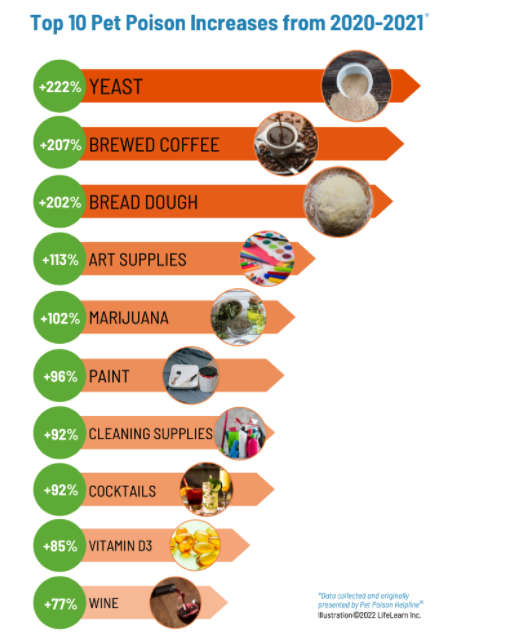
Pet poisoning cases are on the rise; the ASPCA American Poison Control Centre (APCC) assisted in 401,550 cases in 2021 and Pet Poison Helpline (serving Canada, the United States, and the Caribbean) reported a 51% increase in call volume from 2020 to 2021. The rise in cases is considered pandemic-related, with the spike in new pet ownership and in new or reinvigorated activities done at home, such as baking and painting.
According to Pet Poison Helpline, the following everyday household items saw the most dramatic case increases between 2020 to 2021:
 While these numbers represent toxin ingestions that are on the rise, the APCC reported that the most common cases (listed below) made up more than 79% of the total caseload in 2021.
While these numbers represent toxin ingestions that are on the rise, the APCC reported that the most common cases (listed below) made up more than 79% of the total caseload in 2021.
Human over-the-counter (OTC) and prescription medications were the most common toxic items ingested by pets. Any medication (including supplements) can cause toxicity in pets. Common OTC pain killers like acetaminophen (e.g., Tylenol) and non-steroidal anti-inflammatories (e.g., Advil, Aleve, Motrin) are toxic to pets. Prescription antidepressants, cardiac, and ADHD medications are common concerns for pets as well. Be sure to keep ALL medications, including those prescribed to your pets, in locked cabinets or high cupboards.
Chocolate and other food products were next on the list of the most common cases. The APCC claims an average of 103 chocolate-related cases per day! Protein bars/shakes, xylitol, garlic, onion, and grapes/raisins were also frequently reported. Xylitol is a natural substance used as a sugar substitute in many products, including gum, candy, and packaged baked goods. While completely safe for human consumption, xylitol is extremely toxic to dogs and cats. Be careful when sharing your own food with your pets or allowing them to “pre-rinse” the dishes after dessert.
Cool Fact: The toxic component in grapes has been unknown for decades but veterinarians from the APCC made a groundbreaking discovery in 2021 that points to tartaric acid! The amount of tartaric acid in grapes depends on the type, how they are grown, and their ripeness, which might explain how two dogs of similar size could eat the same volume of grapes with one becoming very ill and the other seemingly unaffected. This discovery is recent, so a lot more research is underway!
Indoor and outdoor plants have held the number five spot on the APCC list of most common cases, though there were 7,500 more plant ingestion calls in 2021 compared to 2020. Lilies from the Lilium and Hemerocallis families are very toxic to cats—even the pollen from these plants can cause kidney failure. Early bloomers like tulips and daffodils can cause toxic effects if your pet decides to go digging in your pots and snacks on the bulbs. Take an inventory of the plants you have in your home and garden this spring to be sure your plants are pet safe.
Veterinary products such as calming chews and joint supplements were also a top concern in 2021. That may seem odd because they are formulated to make our pets happy and healthy. These products contain medicinal ingredients that require proper dosing, but they are also made to be palatable with a soft texture and yummy flavors, so they seem like treats to our pets. Just as your pet is likely to overindulge in treats that were left out by accident, the same can be true of veterinary products.
This month, focus on pet-proofing your home to prevent poisoning accidents and to protect your pet from becoming another statistic. As the saying goes, “An ounce of prevention is worth a pound of cure.”